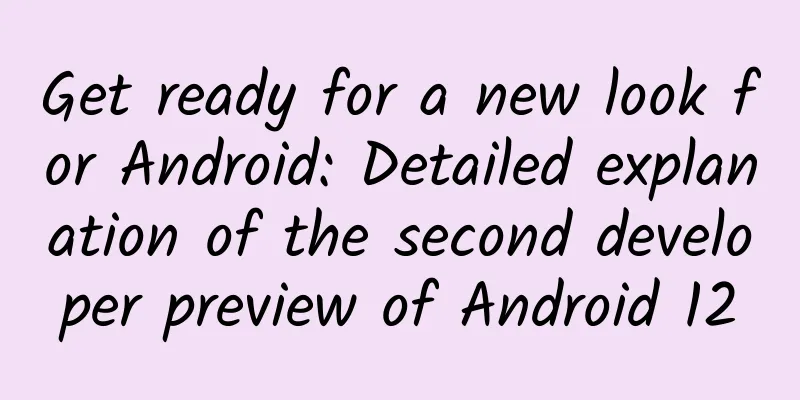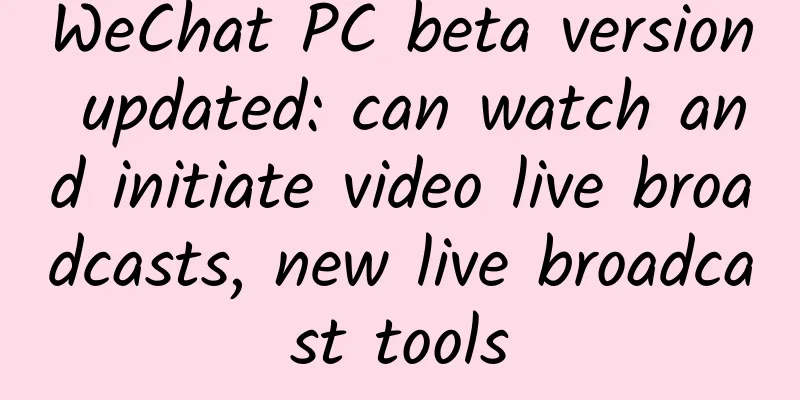Get ready for a new look for Android: Detailed explanation of the second developer preview of Android 12

|
In the early morning of March 18, the second Android 12 developer preview (hereinafter referred to as Android 12 DP2 or DP2) was launched as scheduled, and we are only one step away from the public beta version (Beta) in May. Therefore, before entering the public beta stage, Android 12 can still only be experienced on some Google Pixel devices. If you don’t have a qualified device or don’t want to take the risk of upgrading to try it out, but at the same time want to keep up with the new features and functions of the next generation of Android operating system, you might as well follow this article to find out. The smell of a new theme engine brewing is everywhereWe were quite impressed by the light blue background that runs through a large number of system interfaces in Android 12 DP1, and this change was later confirmed to be paving the way for a new theme engine based on wallpaper color. Android 12 DP1 Because this new theme engine code-named Monet has not yet been launched in Android 12 DP2, the blue background under the DP1 light theme has been temporarily deleted. Android 12 DP2 same interface comparison However, there are many more theme-related UI adjustments, such as high-contrast separators that can be seen everywhere in the system settings, a global light gray background that is more in line with Google's own specifications under the dark theme, and a newly designed widget selection menu similar to the concept design drawings that were exposed earlier: High-contrast dividing lines, more standardized dark theme background colors, and a new widget selection menu This kind of change that paves the way for color or theme can be seen everywhere in DP2. For example, the media playback controls that we have always paid attention to, although Android 12 DP2 did not adjust the poor operation button layout, the background color of the media controls follows the system accent color, instead of the current Android 11 strategy of color filling based on the music album cover. Android 11 vs. Android 12 DP2 Finally, the multitasking interface of Android 12 DP2 also pulls the app icons upward from the top of the app window, making the app icons look like they are floating above the app window. Android 11 | Android 12 DP2 Although this will take up more space, considering that many Android devices now have a screen ratio of 20:9 or even 21:9, such a small change can also make the multitasking interface layout look more coordinated. Picture-in-Picture (PiP) experience is getting betterPiP has received a huge update in Android 12 DP2. In the past, when we used the Home gesture to return to the home screen, the content being played would wait for a while before generating a PiP window on the home screen. The switch from the application to PiP was not natural. Currently the transition from the app to the PiP window is delayed and unnatural | Video content from MKBHD Android 12 DP2 introduces a new auto-PiP API. Apps that adapt to this interface can have a more seamless switching animation when switching from the app to the PiP window. Thanks to our friendly competitors for their encouragement | Image: GadgetHacks Non-video content can also use PiP mode. This may provide new implementation ideas for features such as the "flashback key" based on native interfaces. This type of implementation of domestic UI can be supported by native interfaces | Image: ColorOS The system can adjust the size of the PiP window when needed. This feature may be prepared for specific usage scenarios (such as horizontal screen, split screen). Since there is currently no application adaptation, we have no way of knowing the actual effect. Finally, the PiP window has many new ways to interact.When you need to temporarily view the content in other areas of the screen, you can drag the PiP window to the edge of the screen to temporarily hide it. The hidden PiP window only displays part of the area to avoid interfering with other content on the screen: It can be said to be flexible | Video source in the picture: The Weeknd The touch operation interaction for PiP has also been updated. Now single-clicking the PiP window can call out the playback control, and double-clicking the PiP window can quickly switch between the current window size and the maximum window size. The native system's one-handed mode is officially launchedOne-handed mode was already included in Android 12 DP1, but at that time it could only be enabled through a special Magisk module. In Android 12 DP2, this feature has been officially launched on some Pixel models. According to our tests, the Pixel 3a currently does not have the relevant function after the upgrade, but the Pixel 4 XL can find the relevant entrance in the "System > Gesture" settings. The availability is quite high After turning it on, we can swipe down on the bottom Home bar to enter one-handed mode at any time, and swipe up again to exit. The animation is quite Q-elastic. At the same time, the system also provides some additional settings that are convenient for specific usage scenarios, such as a no-operation timeout option and an automatic exit option after switching applications. Gaussian blur/frosted glass is the next trend?For graphics and image effects, Android 12 DP2 officially introduced a richer effect rendering mechanism, from real-time Gaussian blur to color filters. Developers can apply or combine these effects according to actual needs. However, Google also pointed out in the development documentation that due to the objective existence of processor performance differences, some Android devices may not support these visual features. Google's frosted glass effect Tons of hidden features under developmentIt is a common practice for the Android development team to "hide treasures" in developer previews and beta versions. Some of these hidden features may be launched in the official version, while others may be reserved for the next version (such as screen recording). Fortunately, XDA, which is known for its technical strength and developer resources, has always been happy to "dig for treasures" for users. Next, let’s take a look at the new features hidden in Android 12 DP2. Monet theme engineThe first is naturally the most core new feature of Android 12: the theme engine code-named Monet. Judging from the screenshots released by XDA, the Monet theme engine hidden in Android 12 DP2 can cover more system interfaces after being enabled, such as the Pixel Launcher's long press menu, app drawer background, and the lock screen unlock pattern and PIN code interface mentioned elsewhere in this article. Monet theme engine effect of Android 12 DP2 | Picture: kdrag0n Judging from the screenshots released by developer @kdrag0n who successfully started the theme engine, the implementation of Monet in DP2 has gradually approached the Android 12 concept design that was initially exposed. In addition, the developer also stated that Monet has been upgraded to a CAM 16-based color extraction algorithm in DP2, which can extract and generate more natural and accurate color schemes than the HSL algorithm in DP1. Pixel's "Game Mode"Game mode is also one of the features that has been highly requested for update. In Android 12 DP2, we seem to see that its native Android game mode is coming soon. Although it has not been officially added to DP2, the 9to5Google team has successfully enabled a "game dashboard" feature that is still in the early stages of development in DP2, which includes some features related to game optimization. Image: 9to5Google As can be seen from the screenshots, this game mode includes shortcuts for displaying FPS, screenshots, and do not disturb mode. There are also two larger button controls below the top menu, one of which is currently still blank, and the one on the right is the YouTube Live button, which allows you to quickly broadcast your game screen through YouTube. This seems to be in line with Google's own cloud gaming service Stadia's desire to deeply integrate streaming/live streaming.
Stadia | TechSpot At the same time, 9to5Google also pointed out in the introduction that the relevant code of this game mode is archived in the com.google.android directory, rather than the usual com.android.systemui directory. This means that if this feature eventually appears in Android 12, it will most likely be an exclusive feature of the Google Pixel series rather than a part of the AOSP open source project: However, it is believed that third-party Android ROMs that have specialized in this for many years will not abandon their own game mode and switch to Google's version. New version of search componentIn today's Pixel Launcher, the default launcher for Pixel, all local/online search tasks can only be completed through the search bar that comes with Google Assistant, but in DP2, Google seems to have added a search bar to Pixel Launcher that is more suitable for searching local apps. Legacy Search Component Judging from the screenshots released by 9to5Google, after activating this feature on Pixel Launcher, you can quickly find local applications directly through this search bar; the most important difference between this new search tool and the search bar that Pixel users are already very familiar with is that it does not have any Google Logo, and it cannot be enabled normally in the current DP2. New version of search component | Image: 9to5Google However, what we can expect is that this new search tool will allow users to customize the sources of search results through settings: including applications, app shortcuts, settings options, contacts, and content in the Play Store. Large screen device adaptationWhile many people think that Android tablets are almost doomed, Samsung is still happily updating its own Galaxy tablet devices - now it seems that this confidence may be well-founded. In Android 12 DP2, XDA successfully enabled the taskbar hidden in the Pixel Launcher that is optimized for large-screen devices. This taskbar will provide a permanent application launch and switching area at the bottom of the screen like Chrome OS, which is very suitable for use in tablet or Android system desktop mode. Photo: Mishaal Rahman Automatic rotation based on facial recognitionPeople who like to play with their mobile phones while lying on their side in bed will definitely not turn on the automatic rotation function - although it is a vertical screen usage scenario, the system will adjust the interface to horizontal screen based on sensor data. Previously, we have seen an automatic rotation solution based on face recognition on some Huawei devices. Unexpectedly, this solution came to native Android so soon. According to XDA's excavation, an automatic rotation option based on face is buried in Android 12 DP2. Judging from the settings and function descriptions, the principle should be similar to Huawei's implementation. Screenshot of automatic rotation settings based on facial recognition Unlock pattern/PIN input style adjustmentIn the lock screen interface, Android 12 DP2 changes the style of the Enter key to a unified style with other numeric keys. At the same time, the thin horizontal line separating the numeric keys from the input content is also cancelled. Instead, the “Emergency Call” button has changed from the previous transparent design to the only button in the entire interface filled with the system theme color. Android 11 | Android 12 DP2 In addition to slight adjustments to the PIN interface, the pattern unlocking in DP2 has also undergone some changes: the sliding track has become thicker, and the displayed color has also changed from the previous white to the set theme color. New unlock pattern animation The above visible details may also be paving the way for the upcoming changes. XDA successfully enabled a completely redesigned lock screen PIN input interface in Android 12 DP2. The new interface uses an opaque solid color background, and the background color is extracted from the Monet theme engine mentioned above. At the same time, the number buttons are covered with a compact circular background. Compared with the old interface shown above, this new design always makes people feel familiar... Photo: Mishaal Rahman & kdrag0n Conversation/Contact WidgetHere we have to bring out the concept screenshot that was exposed earlier: Early leaked concept screenshots The various functions and design details in the current developer preview version indicate that the above screenshots are likely to be the final effect that Android 12 wants to present to everyone. XDA successfully enabled the new conversation/contact widgets in this Android 12 DP2. Judging from the screenshots released, these widgets only provide 3x2 size and the design and functions are quite rough at this stage. Functions such as birthdays and call reminders demonstrated in the above picture have not yet appeared. Photo: Mishaal Rahman Bubble notification improvementsThe last one is a hidden feature that I really hope can come to the fore from behind the scenes and become an official feature of Android 12: the bubble notification icon. In the past, the bubble notifications of the Android system only provided text. For some notifications with strange content, we had no way of judging which app was quietly "making trouble" in the background. The new version of bubble notifications tested by Google in Android 12 DP2 can solve this pain point: from the screenshots given by @kdrag0n, the new version of bubble notifications will display notification content and app icons at the same time, just like many third-party ROMs before. Image: kdrag0n Developer-related updatesA more standardized screen rounded corner adaptation solutionAndroid 12 DP2 introduces a series of new APIs to define parameters such as the radius and center point of the screen corners. These new APIs help reduce the workload of developers for UI adaptation for rounded corner screens. Software adaptation specifications once again catch up with hardware form I wonder when Google will standardize the vertical position of the front-facing hole? After all, there are not many Android devices like the Pixel 5 that do not have the front camera tangent to the bottom edge of the status bar. Enhanced companion app connection stabilityAndroid 12 DP2 introduces a new CompanionDeviceService API for Companion Device Manager to ensure that when smart watches, bracelets and other devices are available, companion apps installed on Android phones can be woken up in time and stay connected. Additional security for lock screen notification operationsPreviously, the lock screen notifications of the Android system only provided security verification protection for content display, that is, for the lock screen notifications of some applications, we can choose whether to hide them in the lock screen state. Android 12 DP2 adds the setAuthenticationRequired tag, allowing developers to further protect the lock screen notification operations, such as adding security verification for the read and delete operations of message notifications. Apps can choose to block pop-ups With the newly introduced A more complete way to judge the network environmentBy further enhancing the existing bandwidth estimation APIs, developers can further retrieve information such as device operator, Wi-Fi SSID, network type, signal strength, etc., to obtain simpler but more accurate judgment results and provide content and services in a targeted manner based on the actual network environment and quality (such as providing low-bitrate video transmission when the network speed is poor). Enriching the means of verifying the integrity of application installation packagesFor developers who need to verify the integrity of the installation packages of installed applications, Android 12 DP2 introduces a new checksum API that supports verification of installed applications through algorithms such as SHA256, SHA512, Merkle Root, etc. The above are the new contents worth paying attention to in this Android 12 DP2 update. If you have other discoveries, please leave a message in the comment area to share. See you next month! |
<<: Android 12 developer preview is here: Picture-in-picture is more useful and it’s really good
>>: Mobile phone industry: Do you know these little-known facts about mobile phones?
Recommend
My memory of the college entrance examination | Who said that "idle books" are useless? He applied for astronomy because of popular science books.
Interviewed guest: Li Ran, researcher at the Nati...
Samsung imitates Apple to a new level: copying a Steve Jobs
In the confrontation with Apple, Samsung has alwa...
Is the Earth's "Top Stream" about to "collapse"? This time it may be true
In recent years, people have paid more and more a...
Video account batch diversion, screen domination industry keywords (basic class) comprehensive and systematic explanation of video account gameplay
Video account batch diversion, screen domination ...
Are you only focusing on meat, eggs and milk to supplement protein? You are also missing this "treasure" protein
Speaking of protein Many people's first react...
Tesla lays off half of global recruiting team to cut costs
March 13 news, according to Electrek, in recent w...
Do you know these 4 points about Tencent social advertising?
Do you know all this about Tencent social adverti...
How to deeply interpret those operational professional terms?
"After launching this activity, the daily UV...
How to use Toutiao's recommendation rules to create a hit article with over 1 million readers? (10,000 words of dry goods)
Toutiao has been able to become a disruptor in th...
I heard that eating watermelon for dinner can help you lose weight? Are you a qualified watermelon eater?
Many people saw "eat half a watermelon at ni...
How to completely clear the residual folders after uninstalling mobile APP?
After the files and apps downloaded on the phone ...
How do growth hackers perform operational data analysis?
Attracting new users , promoting activation, and ...
[Energy History 01] A ghost in the water and a flower ended the two thousand years of atomic debate
Atoms: Fantasy or Reality? Nuclear energy, also k...
The Taklimakan Desert is getting wetter! Why is rainfall in southern Xinjiang becoming more frequent?
On August 27, the topic #新疆塔克拉玛干漠发Flood# ranked f...









